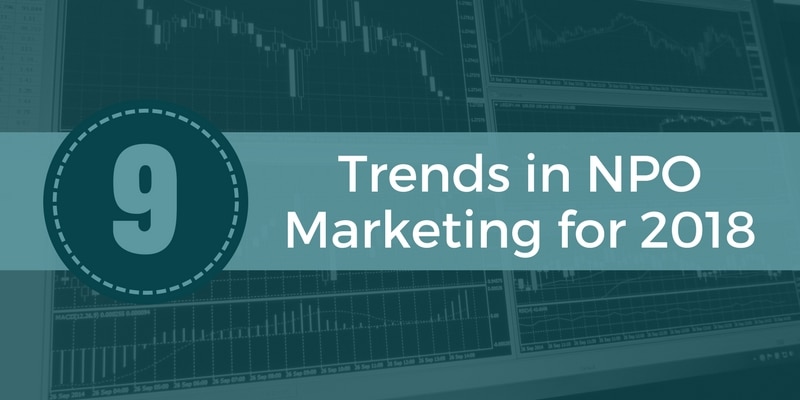When it comes to fundraising so you can make the big things happen for the cause your NPO supports, marketing and getting the name of your organization in front of as many people as possible is essential.
Keeping on top of the latest NPO marketing trends is an integral part of a successful overall strategy. Here are the most significant trends going into this year.
1. Humanized Marketing
More NPOs are creating “donor personas,” taking the lead from a common business marketing practice. Instead of focusing on simply getting the organization’s name out, NPO marketing teams are now looking at making human connections.
Rather than throwing marketing materials out into the ether, nonprofits are taking a much more strategic approach. Personas allow an NPO’s content writer to have a specific reader in mind when creating content and social media posts. This means that the NPO’s marketing will be more targeted, and as a result, more successful with less effort and money.
The second facet of humanized marketing involves giving potential donors and volunteers a “face” to associate with the nonprofit organization. Through focusing on providing a face to an organization, marketers are finding they have a lot more success – both with people’s familiarity with the organization name and with those willing to donate to the cause at hand.
[blockquote type=”left”]Related content: Marketing Tips From NPOs From 22 Pros [/blockquote]
2. Story-Based Marketing
People want to help when there’s a good story behind the cause. In addition to the standard “why my foundation is here” stories, NPOs are successfully sharing stories about the people they help.
For example, in addition to sharing news about the latest research and who they’ve helped, the Preeclampsia Foundation shares the individual stories of mothers who have survived preeclampsia and of those who lost their loved ones to this disease.
This story-based approach not only gets the NPO’s name in front of their intended audience, but it also increases awareness about a very dangerous condition of pregnancy.
3. Livestream Sessions
It’s rare these days that you can pop onto Facebook even for five minutes without having a livestream session pop up in the lower left corner of their screen. Livestreaming, through any of the social media platforms, can be a wildly successful marketing tactic for NPOs.
Whether an organization is going live to share its latest accomplishments, to tell a story, or to offer advice and support to the population it serves, this form of marketing is a great way to get in front of a wide market and to personify the organization.
4. Ephemeral Content
People have a deep fear of missing out. While many livestream platforms allow followers to come back later and watch what they’ve missed, platforms like Snapchat provide content for only a short period of time before it disappears.
Nonprofit organizations have been taking increasing advantage of ephemeral content platforms as a means of engaging their audience and capitalize on the audience’s fear of missing out. This creates a sense of urgency in would-be donors that helps move them from “thinking about it” to doing it.
5. Chatbots And Artificial Intelligence
A lot of companies have started employing chatbots and artificial intelligence as a means of interacting with interested parties. Facebook is one platform for this.
In fact, the Sierra Club and Parents Together have created very successful campaigns using Facebook’s chatbot platform to mobilize people into action – either through signing and sharing petitions or donating money at critical fundraising and action points.
Text message chatbots, such as those used by the Human Rights Campaign, have also been very successful. Chatbots make it very easy for followers to take action or donate, and it brings the organization’s efforts straight to those most likely to make a difference. This form of NPO marketing is only going to grow in coming months.
[blockquote type=”left”]Related content: Examples And Takeaways Of Great NPO Marketing On A Budget [/blockquote]
 6. Mobile Technology That Simplifies Giving
6. Mobile Technology That Simplifies Giving
Most of us are familiar with texting a number with a code to donate money through our cell phones to a charity – this was a really popular means for giving with the 2010 Haiti earthquake, and the Red Cross had a very successful campaign.
In fact, this remains a popular method of post-disaster fundraising for the Red Cross. Since then, there have been a lot of new methods for making donations using mobile technology that have popped up. As a matter of fact, there was a 7.9% increase in online giving in 2016 in the United States.
There was a 7.9% increase in online giving in 2016 in the United States.Click To TweetPayments via email buttons, fundraisers on Facebook, and mobile wallets all have contributed toward the increase in using mobile technology as a means for simplified giving. It’s important that nonprofit organizations take advantage of appealing to the convenience of giving through social media platforms and other mobile apps.
7. Peer-To-Peer Fundraising
The Juvenile Diabetes Research Foundation provides money for type 1 diabetes research. They have a variety of ways that people can get involved, and help to fundraise for them. One of the things they do to raise money is the One Walk, where individuals walk with sponsors who donate money through the walker to the cause.
There are many successful fundraising campaigns that rely upon one person to market the fundraising to those they know already, that’s not new (Komen’s Race for the Cure, CROP Hunger Walks, etc.). Nor is the “challenge” idea that was wildly successful with ALS’s bucket challenge.
What is new is the ease of sharing made possible through Chatbots. It’s also now possible for individuals to create their own fundraisers in honor of special events, like birthdays, and solicit their friends for donations in lieu of gifts on social media platforms.
8. Virtual Races
Another trend in the past couple years has been marketing and fundraising through the virtual race. While a lot of big charity organizations put on races, doing so can be expensive. Virtual races allow participants to run or walk for a cause at their convenience.
The benefit to nonprofit organizations is that all proceeds past the cost of the virtual race platform (and sometimes the finisher’s medal and shirt, depending on the platform) go to the organization instead of to security, food for after the race, fees for the race space, route and event planning, etc.
Since virtual races are becoming increasingly popular in the running community, this trend in hosting them is picking up speed in the NPO community. A lot of the smaller nonprofits are finding an audience this way.
9. The Virtual Generation, Generation Z, Is Coming Of Age
These 18-19-year-olds and those in their early 20s have been in front of screens for pretty much their entire lives. They are very social-media savvy, and they are expert navigators of content.
This generation is engaged, and a lot of them were mobilized into action for social good during the 2016 election cycle. While many of them are still in college, marketing to them is increasingly important, particularly to engage peer-to-peer fundraising efforts and to gain new volunteers until they start to have more money than time.
Many NPOs are spending time marketing to this generation, and rightly so. They make up a sizable chunk of the population.
These are the biggest trends right now in NPO marketing and fundraising techniques. Almost all of them point to an increasing desire of donors and volunteers to “get to know the face of” the nonprofits they support. This is part of a broader over-all trend in content marketing in particular of humanizing content and marketing for a specific imagined reader.
[inf_infusionsoft_inline optin_id=optin_9]
Ronda Bowen is VP of Editorial Services at Creative Mindscape. She also provides editorial consulting services to a variety of businesses and individuals, runs a handful of blogs (including WiningWife®), and serves as Fundraising Director for JB Dondolo, Inc. In her downtime, she’s a distance runner, a foodie, a wine and coffee aficionado, seamstress and crafter, and board game enthusiast. Learn more about Ronda’s various projects on her website.




